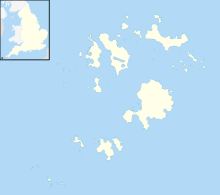Peninnis Head
| Site of Special Scientific Interest | |

Penninnis Head with lighthouse
|
|
| Area of Search | Cornwall |
|---|---|
| Grid reference | SV911094 |
| Coordinates | 49°54′19″N 6°18′10″W / 49.9053°N 6.3029°WCoordinates: 49°54′19″N 6°18′10″W / 49.9053°N 6.3029°W |
| Interest | Biological and Geological |
| Area | 16.1 hectares (0.161 km2; 0.0622 sq mi) |
| Notification | 1971 |
| Natural England website | |
Peninnis Head is the southernmost point of St Mary’s, Isles of Scilly. The headland is within the Isles of Scilly Area of Outstanding Natural Beauty and part of the Heritage Coast. It is also a Geological Conservation Review site for its Quaternary geomorphology and was first designated a Site of Special Scientific Interest (SSSI) in 1971 for both its biological and geological interests. On the tip of the headland is a squat lighthouse built in 1911 by Trinity House as a replacement for the 17th century lighthouse on St Agnes.
The Gilstone, a prominent rock off the eastern side of Peninnis Head, should not be confused with a rock of the same name in the Western Rocks.
The headland is composed of coarse–grained Hercynian granite which has weathered to form cairns and natural sculptures with names such as the Pulpit Rock. In places head deposits have accumulated and thin podzolic soils have formed over the granite which is ideal for the formation of waved maritime heath vegetation. Peninnis Head is a Geological Conservation Review site because of the lack of glacial features which makes it possible to compare with sites, such as on Tresco in the north of the islands, where the granite has had some contact with glacial ice.
Western gorse (Ulex gallii), heather (Calluna vulgaris) and bell heather (Erica cinerea) are the main components of the waved maritime heath and on the deeper soils bracken (Pteridium aquilinum), European gorse (U. europaeus), bramble (Rubus fruticosus) and honeysuckle (Lonicera periclymenum) are encroaching and devaluing the vegetation which is why the condition of the SSSI is considered to be unfavourable recovering. Grazing under a HLS agreement should help the vegetation to recover. Two unusual plants (for the Isles of Scilly) in the species–rich maritime grassland are spring squill (Scilla verna) and thyme (Thymus polytrichus). The dominant species are red fescue (Festuca rubra), Yorkshire fog (Holcus lanatus), thrift (Armeria maritima), sea beet (Beta vulgaris subsp. maritima), common sorrel (Rumex acetosa), common scurvygrass (Cochlearia officinalis) and buck's–horn plantain (Plantago coronopus). The nationally scarce early meadowgrass (Poa infirma) and western clover (Trifolium occidentale) also occur.
...
Wikipedia

